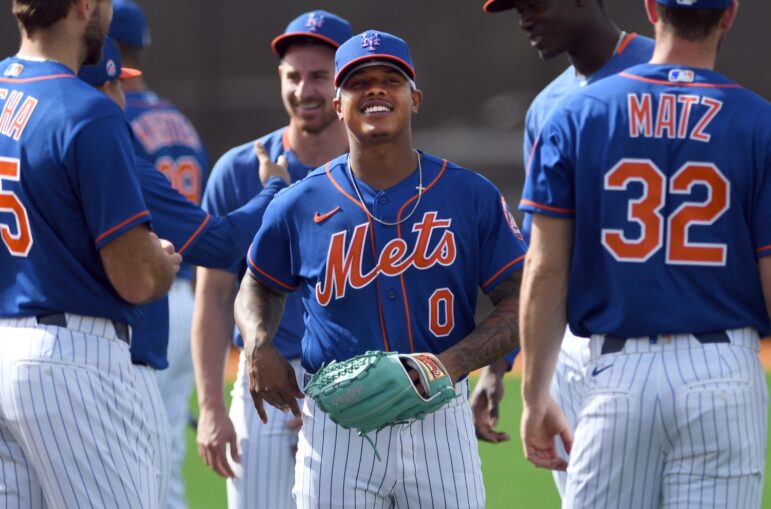
Heading into this offseason, it’s clear the New York Mets must address their starting pitching concerns by adding one or two arms over the next few months, but could that include bringing back a player who opted out of the 2020 campaign? Potentially.
Prior to Major League Baseball’s shutdown in March, pitcher Marcus Stroman was expected to take on a much larger role during his first full season in Queens, especially with teammate Noah Syndergaard sidelined with Tommy John surgery.
But once players returned to the field in July, everything changed for the 5-foot-7 hurler, as he suffered a partially torn calf and ultimately chose to end his season shortly after.
While his 2020 campaign ended before it even began, the 29-year old is still slated to hit the open market for the first time in his career and will likely be looking to command a lucrative contract this winter.
That said, there’s a very good chance plenty of teams across the league will find it difficult to determine his value, which could significantly impact his offseason plans.
Since Stroman will be entering his age-30 season in 2021 and he’s coming off a serious calf injury, it’s possible the former first-round pick could struggle to find his next destination, especially since the COVID-19 pandemic will probably force organizations to limit their spending.
To make matters worse, the veteran hurler could have a qualifying offer attached to him, which would likely diminish his value even further.
With all of these factors in mind, a return to Queens next season doesn’t exactly seem impossible at this point for either side.
Considering the package of prospects (Anthony Kay and Simeon Woods Richardson) general manager Brodie Van Wagenen surrendered to land Stroman, it’d make plenty of sense to keep him around for at least one more season and then potentially part ways after the 2021 campaign.
So what would it take to convince the New York native to stay?
Well, the easiest way would be for him to sign a qualifying offer, which is slated to increase to $18.9 million this offseason.
Since the one-time All-Star was scheduled to earn $12 million in 2020, this salary would provide him an outstanding raise and it would allow him to re-enter free agency once next season concludes.
Another way the Mets could retain Stroman for the 2021 campaign would be offering him a one-year deal that’s worth less than the qualifying offer, perhaps somewhere around $13-$16 million, but also includes a player option for the 2022 season.

While that option would likely be valued slightly below his 2021 salary, it would still provide him with some security if he endures an injury-riddled campaign or struggles to replicate his 2019 performance.
Even though the right-hander never returned to the mound this past season, he was able to produce one of the best statistical performances of his career last season and could definitely help strengthen the team’s starting pitching depth.
Based on his results split between the Mets and the Blue Jays, it wouldn’t be shocking to watch him generate another impressive showing in 2021.
Over his 32 starts (21 with Toronto and 11 with New York) in 2019, Stroman compiled 184 1/3 innings, producing a 3.22 ERA (2.32 decrease from 2018), 3.73 xERA (0.74 decrease), 3.72 FIP (0.19 decrease), 3.99 xFIP, 73 ERA- (tied for 13th-lowest among all qualified starters).
The right-hander also has a 82 FIP- (tied for 16th-lowest), 1.31 WHIP (0.17 decrease), .256 OPP AVG (0.24 decrease), 20.5% strike out rate (3.4% increase), 7.5% walk rate (0.5% decrease), 20.1% LD rate (tied for 12th-lowest), 53.7% GB rate (fourth-highest), 26.1% FB rate (fourth-lowest), 12.6% HR/FB rate (1.0% decrease), and a 34.2% hard-hit rate (tied for 12th-lowest), according to FanGraphs.com.
In addition, the 2017 Gold Glove award winner also recorded a career-best 4.1% barrel rate, which ranked in the top six percent of the league, and he lowered his average exit velocity by 1.2 mph (88.2 mph).
Adding to his suddenly impressive ability to generate swings and misses, he also increased his chase rate by 4.0% (28.6%) and his whiff rate by 2.3% (24.7%).
Taking his production even further, Stromans’ success with his mid-80s slider played a major factor in his ability to bounce back from his disappointing 2018 performance.
As a result, “Stro-Show” regained his primary strikeout weapon, which allowed him to showcase his full potential with it.
Through his 184 1/3 innings of work, the Duke standout utilized his breaking ball 30.9% of the time, creating a .168 AVG (.062 decrease from 2018), .197 xAVG (.021 decrease), .239 SLG (.056 decrease), .309 xSLG, .191 wOBA (.064 decrease), .233 xwOBA (.016 decrease), 33.9% strikeout rate (5.4% increase), 35.3% whiff rate (2.7% increase), 36.9% chase rate (5.3% increase), and a 3.6% walk rate (2.6% decrease) against it.
Additionally, he’s also increased his slider’s spin rate by 179 RPMs (2838) since 2018.
If Stroman does indeed return to New York next season, it’ll be crucial for him to replicate these results against his slider and continue inducing plenty of ground balls with both his sinker and cutter.
That said, staying healthy will also prove to be equally important, as he’ll be taking the mound for the first time in nearly a year if and when spring training opens next spring.
With the Mets still looking to return to the playoffs for the first time since 2016, their front office is expected to be very aggressive in free agency this winter and could become one of several teams who’ll make a serious run at pitcher Trevor Bauer, who’s considered the top hurler available in this year’s class.
But since the team isn’t expected to encounter any financial issues this offseason, the door is certainly open for them to invest plenty of money into their starting rotation, which will hopefully improve the club’s chances of making the postseason in 2021.
















